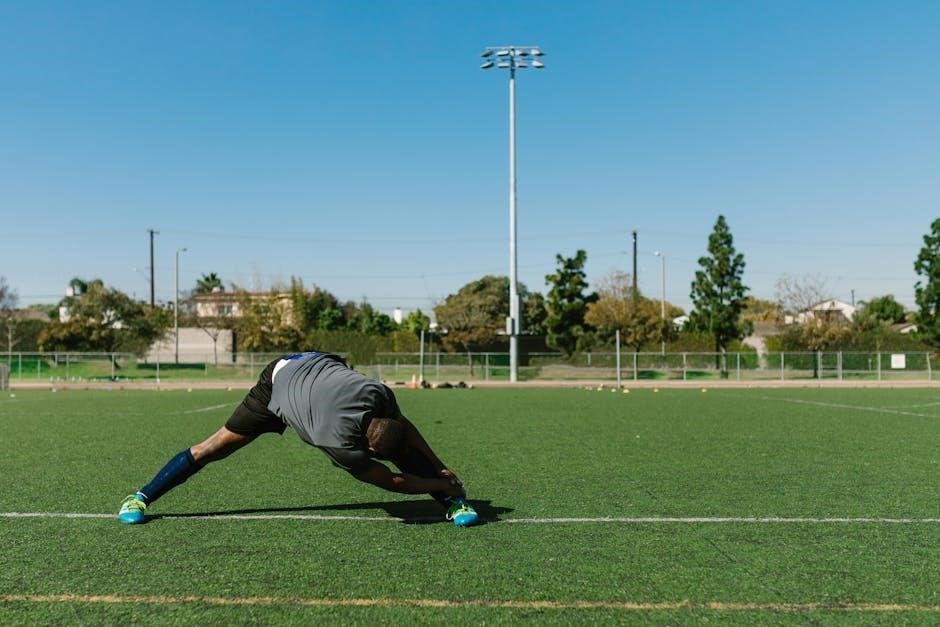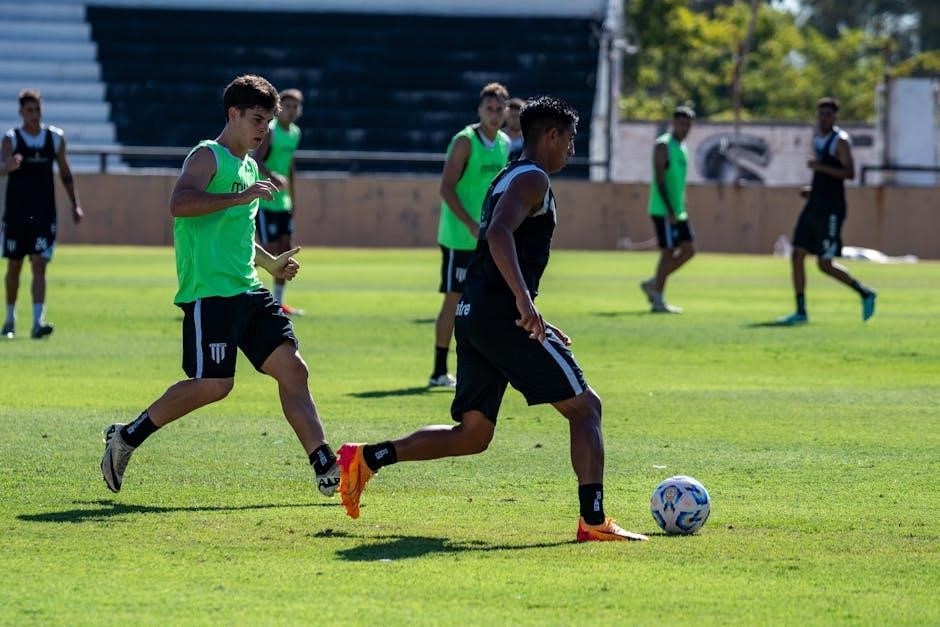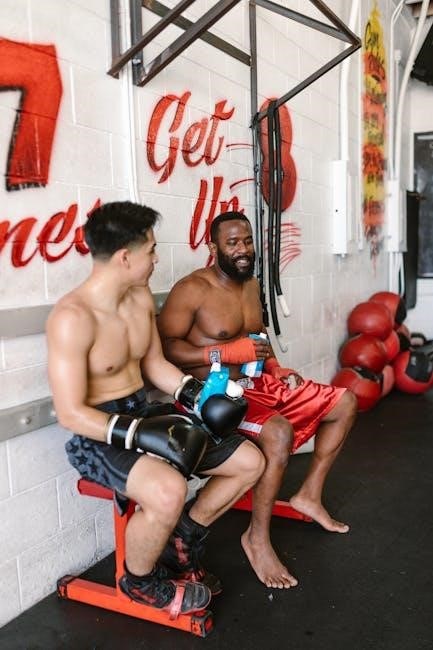
-
By:
- ophelia
- No comment
d1 college football workout program pdf
D1 college football workout programs are elite, comprehensive training plans designed for year-round athlete development, integrating strength, speed, agility, and conditioning exercises to enhance performance and minimize injury risks.
Overview of the Importance of Structured Training
Structured training is essential for D1 college football athletes to achieve peak performance and minimize injury risks. A well-planned program ensures balanced development of strength, speed, and endurance, aligning with the sport’s demands. Without structure, athletes risk overtraining or undertraining, leading to suboptimal results. Structured programs divide the year into distinct phases—off-season, in-season, and post-season—each tailored to specific goals. This approach maximizes physical development while maintaining safety and efficiency. Coaches use these plans to customize training to individual and team needs, ensuring optimal preparation for competition. Resources like PDF guides and manuals provide detailed frameworks, helping athletes follow progressive and structured regimens. Structured training is non-negotiable for success at the elite collegiate level, ensuring athletes are consistently prepared to compete at their best.
Key Components of a D1 Football Workout Program
A D1 football workout program is built around several key components, including strength training, speed and agility drills, plyometrics, and conditioning exercises. These elements are designed to enhance power, explosiveness, and endurance while reducing injury risk. Strength training focuses on lower body, upper body, and core exercises, such as squats, bench presses, and planks, to build functional strength. Speed and agility drills, including sprinting and cone exercises, improve quickness and change-of-direction skills. Plyometric exercises, like box jumps and burpees, develop explosive power. Conditioning drills, such as gassers and pro agility shuttle runs, build endurance and stamina. Additionally, nutrition and recovery strategies are integrated to ensure optimal performance. Each component is carefully structured to address the physical and metabolic demands of elite-level football, creating a well-rounded athlete prepared for competition.
Phases of the Training Year: Off-Season, In-Season, and Post-Season
D1 college football training is divided into three distinct phases: off-season, in-season, and post-season. The off-season focuses on building foundational strength, speed, and endurance through intensive weightlifting and conditioning programs. This phase emphasizes injury prevention and laying the groundwork for future performance. The in-season phase shifts to maintaining strength and stamina while optimizing recovery to ensure peak performance during games. Coaches prioritize recovery techniques and strategic training to avoid overtraining. The post-season centers on rehabilitation and recovery, allowing athletes to heal and address any injuries. This phase also prepares players for the next training cycle, ensuring a smooth transition. Each phase is tailored to meet the physical demands of the sport, ensuring athletes are prepared for competition and long-term development.

Strength Training Fundamentals
Strength training is a cornerstone of D1 football workouts, focusing on lower body, upper body, and core exercises to build power, endurance, and functional strength for peak performance.
Lower Body Strength: Exercises and Importance
Lower body strength is critical for D1 football players, focusing on exercises like squats, deadlifts, and lunges to build power and explosiveness. These movements target the quadriceps, hamstrings, and glutes, essential for acceleration and stability on the field. Plyometric variations, such as jump squats, enhance explosive power. Proper form and progressive overload are emphasized to maximize gains while minimizing injury risk. A well-structured lower body program ensures players can dominate in both speed and strength, making it a cornerstone of any D1 football workout plan. Consistency and intensity are key to achieving peak performance.
Upper Body Strength: Building Power and Endurance
Upper body strength is vital for D1 football players, focusing on exercises like bench presses, pull-ups, and overhead presses to build power and endurance. These movements target the chest, shoulders, and back, enhancing blocking, tackling, and overall durability. Incline bench presses and dumbbell variations improve specificity, while row exercises strengthen the lat muscles for better posture and stability. A balanced upper body program ensures players can maintain dominance in physical confrontations on the field. Proper form and progressive overload are prioritized to maximize gains safely and effectively.
Core Strength: Enhancing Stability and Explosive Power
Core strength is foundational for D1 football players, enhancing stability, balance, and explosive power. Exercises like planks, Russian twists, and rotational movements target the abdominals, obliques, and lower back. These workouts improve posture, reduce injury risk, and boost overall athleticism. Stability drills, such as single-leg balances and medicine ball tosses, further refine coordination and functional strength. A strong core enables players to generate force efficiently, making it a critical component of any D1 football workout program. Consistency in core training ensures players maintain peak performance throughout the season. By building a robust core, athletes can enhance their ability to explosively accelerate and decelerate, giving them a competitive edge on the field.

Speed and Agility Development
Speed and agility development is crucial for D1 football players, enhancing quickness, reaction time, and explosiveness through targeted drills like sprints, cone exercises, and change-of-direction workouts.
Sprinting Drills: Enhancing Speed and Acceleration
Sprinting drills are a cornerstone of D1 football training, designed to enhance speed, acceleration, and explosiveness. Incline sprints target leg strength and endurance, while whistle sprints improve reaction time and stamina. Goal line runs simulate game conditions, boosting acceleration and mental toughness. Players perform multiple sets of short and long sprints, varying intensity to mimic real-game demands. Coaches incorporate speed variations, such as slow, medium, and fast runs, to maximize efficiency. These drills are tailored to specific positions, ensuring athletes develop the agility and quickness needed for competitive play. Proper form and progressive overload are emphasized to maximize gains while minimizing injury risks, making sprinting drills essential for peak performance on the field.
Cone Drills: Improving Agility and Change-of-Direction Skills
Cone drills are essential for enhancing agility, quickness, and change-of-direction skills in D1 football players. Common exercises include cone weaves, shuttle runs, and ladder drills. Players navigate cones in zigzag patterns or perform rapid lateral movements to improve flexibility and reaction time. Coaches often incorporate variations, such as adding speed changes or directional shifts, to mimic game scenarios. These drills are tailored to specific positions, ensuring players develop the agility needed for their roles. Proper technique and intensity are emphasized to maximize performance and reduce injury risks. Cone drills are a fundamental component of D1 football training, helping athletes excel in dynamic, fast-paced environments by refining their ability to change direction swiftly and efficiently.

Plyometrics and Conditioning
Plyometrics and conditioning focus on enhancing explosive power and endurance through exercises like box jumps and gassers, combining strength and speed for optimal athletic performance.
Plyometric Exercises: Building Explosive Power
Plyometric exercises are essential for developing explosive power in D1 football players. Common drills include box jumps, depth jumps, and burpees, which enhance vertical and horizontal explosiveness. These exercises focus on rapid, powerful movements that mimic game situations, improving acceleration, deceleration, and change-of-direction speed. Proper form and progression are critical to avoid injury, with coaches often combining plyometrics with strength training for maximum results. For example, box jumps target leg power, while depth jumps enhance reactive strength. Plyometric variations, such as lateral box jumps or single-leg hops, further refine agility and positional specificity. Consistency in plyometric training ensures athletes can generate force efficiently, making it a cornerstone of any successful D1 football workout program. These exercises are tailored to individual fitness levels and sport-specific demands, optimizing performance on the field.
Conditioning Drills: Enhancing Endurance and Stamina
Conditioning drills are vital for building the endurance and stamina necessary for D1 football. Exercises like gassers, pro agility shuttle runs, and hill sprints simulate game demands, improving anaerobic endurance and speed. Tempo runs and interval training boost muscular endurance, enabling players to maintain intensity throughout games. These drills are designed to enhance cardiovascular fitness and mental toughness, ensuring athletes can perform at peak levels over extended periods. Proper recovery and hydration strategies are emphasized to optimize performance and prevent fatigue. A well-structured conditioning program is essential for sustaining high-energy efforts, making it a critical component of any successful D1 football workout plan. These exercises prepare players to endure the physical and mental challenges of competitive football.

Nutrition and Recovery Strategies
Nutrition and recovery are critical for D1 football athletes, focusing on balanced diets rich in proteins, carbs, and fats to fuel performance and aid muscle recovery. Proper hydration strategies optimize physical output and recovery.
Meal Planning: Fueling for Optimal Performance
Meal planning is a cornerstone of D1 football success, ensuring athletes fuel their bodies with balanced diets rich in lean proteins, complex carbs, and healthy fats. Proper nutrition supports muscle growth, energy needs, and recovery. Timing meals around workouts is crucial, with pre-game meals focusing on easily digestible carbs and proteins. Post-workout nutrition prioritizes replenishing glycogen stores and repairing muscles. Hydration strategies are also vital, with personalized plans to match training intensity. Coaches and nutritionists often tailor meal plans to individual needs, ensuring optimal performance. A well-structured diet not only enhances physical output but also aids in injury prevention and mental clarity. Consistency in meal planning is key, with regular monitoring to adjust for changing training demands and seasonal requirements.
Hydration and Recovery: Essential for Peak Output
Hydration and recovery are critical components of a D1 football workout program, ensuring athletes maintain peak physical and mental performance. Proper hydration strategies are tailored to individual needs and training intensity, preventing fatigue and optimizing recovery. Active recovery techniques, such as ice baths, stretching, and foam rolling, reduce muscle soreness and improve flexibility. Adequate rest and sleep are emphasized to allow muscles to repair and rebuild, enhancing overall resilience. Neglecting recovery can lead to decreased performance and increased injury risk. Coaches often integrate recovery protocols into daily routines, ensuring athletes are prepared for the next training session. By prioritizing hydration and recovery, D1 football players can sustain high-intensity efforts and maintain health throughout the season.

Off-Season Training Focus
Off-season training focuses on building foundational strength, endurance, and injury prevention techniques, ensuring athletes are prepared for the upcoming season with a strong physical base.
Building Foundational Strength and Endurance
Building foundational strength and endurance is a critical component of the off-season training phase for D1 college football athletes. This period emphasizes intensive weightlifting and conditioning programs designed to enhance muscle mass, power, and cardiovascular fitness. Workouts typically include lower body exercises such as squats, deadlifts, and lunges, which target the quadriceps, hamstrings, and glutes to improve explosiveness and stability. Upper body training incorporates bench presses, pull-ups, and overhead presses to build strength and endurance in the chest, shoulders, and back. Core exercises like planks and Russian twists are also essential for improving stability and balance. Additionally, plyometric drills and conditioning exercises like gassers and hill sprints are used to boost explosive power and stamina, ensuring athletes are physically prepared for the demands of the upcoming season.
Incorporating Injury Prevention Techniques
Incorporating injury prevention techniques is a vital aspect of D1 college football workout programs, ensuring athletes maintain peak performance while minimizing injury risks. These strategies include structured warm-ups, dynamic stretching, and mobility exercises to enhance flexibility and reduce muscle tightness. Coaches often integrate injury prevention drills into daily routines, focusing on proper movement mechanics and muscle balance. For example, exercises targeting the core and shoulder stabilize joints and prevent common injuries. Additionally, plyometric and agility drills are designed to improve reactive strength and reduce the risk of non-contact injuries. Personalized approaches, such as addressing individual muscle imbalances, further enhance injury prevention. By prioritizing these techniques, D1 programs create a safer and more effective training environment, allowing athletes to perform at their best throughout the season.

In-Season Training Strategies
In-season training focuses on maintaining strength, stamina, and optimizing recovery to ensure peak performance during games, with strategies tailored to preserve player health and maximize effectiveness.
Maintaining Strength and Stamina
Maintaining strength and stamina during the in-season period is crucial for D1 football players to sustain performance levels. Coaches implement tailored programs that balance strength training with recovery, ensuring athletes retain muscle mass and endurance. Workouts often include lower-intensity, high-efficiency exercises like dynamic warm-ups, resistance bands, and core stabilization drills. These routines focus on maintaining power without overtaxing the body. Additionally, plyometric exercises are scaled back to preserve explosiveness while minimizing fatigue. Proper nutrition and hydration strategies are emphasized to fuel workouts and aid recovery. By prioritizing maintenance, players can uphold their physical capabilities throughout the season, ensuring consistent performance on the field. This approach is vital for competing at the elite collegiate level.
Optimizing Recovery for Game Performance
Optimizing recovery is essential for D1 football athletes to maintain peak performance during the season. Coaches emphasize hydration, nutrition, and sleep as foundational elements of recovery strategies. Techniques like ice baths, stretching, and compression garments are commonly used to reduce muscle soreness and improve circulation. Additionally, active recovery methods, such as yoga or light cardio, are incorporated to promote flexibility and mental relaxation. Proper recovery ensures players can withstand the physical demands of consecutive games and training sessions. By prioritizing recovery, athletes can maintain energy levels, prevent fatigue, and sustain their competitive edge throughout the season. This holistic approach to recovery is critical for achieving and maintaining elite performance in D1 college football.

Post-Season Recovery and Rehabilitation
Post-season recovery focuses on rehabilitation techniques and allowing bodies to heal. It includes physical therapy, rest, and gradual reintroduction to training, preparing athletes for the next cycle.
Rehabilitation Techniques for Injury Recovery
Rehabilitation techniques in D1 college football focus on restoring strength, flexibility, and function after injuries. Methods include physical therapy, ice, compression, and elevation (RICE), along with controlled exercises like light cardio and mobility drills. Athletic trainers and physical therapists design personalized recovery plans to address specific injuries, such as ACL tears or muscle strains. These plans often incorporate low-impact activities, such as swimming or cycling, to maintain fitness without stressing injured areas. Gradually reintroducing strength training and sport-specific movements helps athletes regain peak performance. Proper nutrition and hydration are also emphasized to support the healing process. The goal is to ensure full recovery, prevent future injuries, and prepare players for the next training cycle. Rehabilitation is a critical phase for long-term health and competitive success.
Preparing for the Next Training Cycle
Preparing for the next training cycle in a D1 college football workout program involves a strategic transition from post-season recovery to rebuilding foundational strength and endurance. This phase emphasizes setting clear performance goals and analyzing past training data to identify areas for improvement. Athletes engage in light conditioning and mobility exercises to maintain fitness while allowing their bodies to fully recover. Coaches often introduce new techniques or adjustments to previous routines to address specific weaknesses. Gradually increasing the intensity of workouts ensures a smooth progression into the off-season training phase. Proper nutrition, hydration, and sleep are prioritized to support the body’s adaptation. This preparatory period is crucial for building a strong foundation and mentally resetting for the demands of the upcoming season.

Sample Workout Plan Structure
A D1 college football workout plan includes a weekly schedule balancing strength, conditioning, and recovery. PDF manuals provide detailed structures, ensuring progressive overload for continuous improvement and peak performance.
Weekly Training Schedule: Balancing Strength and Conditioning
A well-structured D1 college football workout program typically follows a weekly schedule that balances strength training, conditioning exercises, and recovery. The program is divided into specific days, with strength workouts often taking place 4-5 times a week, focusing on lower body, upper body, and core exercises. Conditioning days are strategically incorporated to enhance endurance and stamina, often including sprinting drills, agility exercises, and plyometric workouts. Recovery is also a key component, with rest days or light activities to allow muscles to repair and rebuild. The schedule is designed to avoid overtraining while maximizing physical development. Proper progression and periodization ensure athletes are prepared for the demands of the season, maintaining peak performance throughout the year.
Progressive Overload: Ensuring Continuous Improvement
Progressive overload is a fundamental principle in D1 college football workout programs, ensuring continuous improvement by gradually increasing the intensity of training. This involves systematically adding weight, reps, or sets over time to challenge muscles and enhance strength, power, and endurance. Coaches implement this by adjusting resistance, volume, or intensity based on athlete progress. Proper form and technique are emphasized to prevent injury while maximizing gains. Periodization is also used to structure overload phases, allowing for peak performance during critical periods. Tailored to individual needs, progressive overload ensures athletes consistently improve without plateaus, making it a cornerstone of elite-level training programs designed to compete at the highest collegiate level.

Resources and Guides
D1 college football workout programs often include PDF manuals and training guides, providing structured plans and expert insights from experienced coaches to optimize athlete development.
PDF Manuals and Training Guides
D1 college football workout programs are often supported by detailed PDF manuals and training guides, providing athletes with structured plans for strength, speed, and conditioning. These resources, such as the Texas Football Strength and Conditioning Manual and the Faulkner University Football Strength Manual, outline exercises, drills, and nutrition advice tailored for elite performance. They typically include phased training plans, emphasizing hypertrophy, strength, and power development, while incorporating injury prevention techniques. Many guides are designed by experienced coaches, offering insights into sport-specific movements and recovery strategies. These manuals serve as essential tools for athletes aiming to reach D1-level fitness, ensuring a comprehensive approach to physical preparation and peak performance.
Expert Coaches and Their Contributions to Program Design
Expert coaches play a pivotal role in designing D1 college football workout programs, bringing decades of experience and proven methodologies to optimize athlete performance. Coaches like Coach Horton, with over 20 years of experience, specialize in creating structured plans that balance strength, speed, and conditioning while minimizing injury risks. Their expertise extends to tailoring programs for individual needs, ensuring each athlete reaches their full potential. These coaches often integrate cutting-edge techniques, such as plyometrics and sport-specific drills, to enhance explosiveness and agility. Their contributions are instrumental in shaping successful programs, as they combine scientific knowledge with practical insights to drive peak performance. The influence of expert coaches is evident in the comprehensive and elite-level training plans that define D1 football.
D1 college football workout programs are comprehensive, elite-level plans that integrate strength, speed, and conditioning to optimize performance, guided by expert coaches for peak athlete development and success.
Summarizing the Key Elements of a Successful D1 Workout Program
A successful D1 workout program combines structured strength training, speed, agility, and conditioning exercises tailored to enhance performance and reduce injury risks. It is divided into three phases: off-season, in-season, and post-season. The off-season focuses on building foundational strength and endurance, while the in-season maintains strength and optimizes recovery. The post-season emphasizes rehabilitation and preparation for the next cycle. Nutrition and hydration strategies are integral, ensuring athletes fuel optimally and recover efficiently; Expert coaches design these programs, incorporating progressive overload and sport-specific movements. Each component is carefully structured to address physical demands, creating a well-rounded athlete capable of excelling at the elite collegiate level. Proper execution ensures peak performance, longevity, and competitiveness in the sport.
Final Thoughts on Achieving Peak Performance
Achieving peak performance in D1 college football requires unwavering dedication to a structured workout program, proper nutrition, and recovery. A well-designed program, guided by expert coaches, ensures athletes develop the strength, speed, and endurance needed to excel. Consistency in training, attention to injury prevention, and a holistic approach to physical and mental preparation are crucial. By adhering to these principles, athletes can maximize their potential, minimize risks, and achieve long-term success in their football careers. The combination of elite-level training and personalized care fosters a competitive edge, enabling players to perform at their best when it matters most.